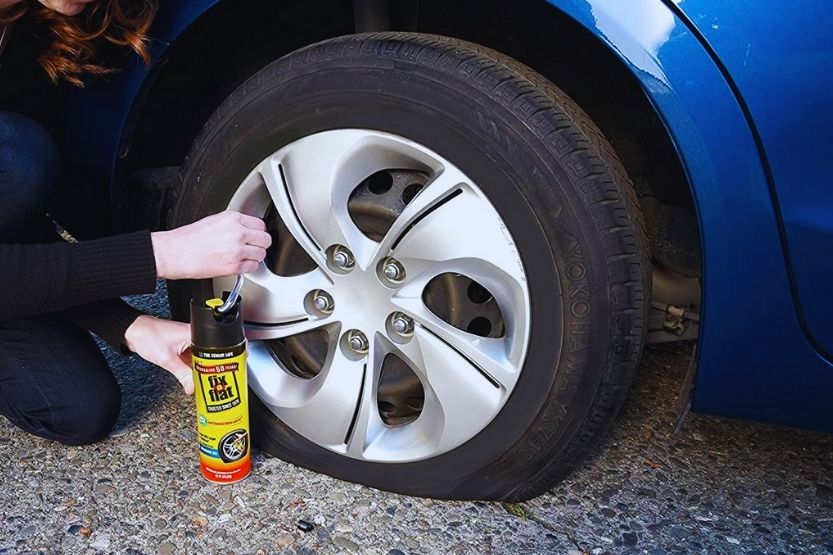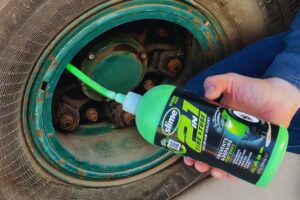There’s nothing worse than getting a flat tire in the middle of the road. No spare tire in your trunk and miles away from the nearest mechanic. It is handy to have a can of Fix-a-Flat in such an emergency along with you. So, how do you use Fix-a-Flat to keep your tire inflated for a significant period temporarily?
Here are the steps on how to use a Fix-a-Flat:
- Park the Car and Brace the Tire
- Jack Up Your Car
- Identify the Leak and Check the Tire Pressure
- Open the Tire Valve
- Repair the Tire
- Inflate Your Tire to the Recommended Tire Air Pressure
- Put the Tire Valve Back
- Drive Your Car to the Nearest Service Station
Read on to learn more about how to use Fix-a-Flat.
How to Use Fix-a-Flat

Fix-a-Flat (FAF) is a single-use flat tire sealant in a can. This provides a fast and temporary solution in a flat tire emergency, filling in the puncture in a tire or re-inflating it.
It is not a permanent fix. But you can plug up your tire and drive on it for a considerable distance until you replace it.
Steps on How to Use Fix-a-Flat
If you’re using Fix-a-Flat for the first time, refer to the product instructions tag for the application procedure. It will keep you informed of any issues you might encounter.
Aside from a can of Fix-a-Flat, you will also need the following:
- A car jack,
- Portable flat tire air pressure pump, and
- Breakdown road sign (optional).
To begin plugging your flat tire with Fix-a-Flat, do the following steps:
- Park the Car and Brace the Tire
- Jack Up Your Car
- Identify the Leak and Check the Tire Pressure
- Open the Tire Valve
- Repair the Tire
- Inflate Your Tire to the Recommended Tire Air Pressure
- Put the Tire Valve Back
- Drive Your Car to the Nearest Service Station
1. Park the Car and Brace the Tire
Pull out your car from the street or highway to a safe side of the road. You can also get your vehicle to a car park if you can. Make sure to park your car away from the traffic.
Park on a flat surface to avoid further damaging the flat tire. Also, keep your hazard lights on while the vehicle is on the roadside.
Look for bracing material such as bricks or timber wedges. Place them in front of and behind the tires, which won’t be lifted.
Remember that the hand brake will be kept free so that you can rotate the flat tire. The bricks or timber wedges will keep your car stable and prevent it from rolling.
2. Jack Up Your Car
Consult your user’s manual if you’re jacking up your car for the first time. Make sure that the jack is in a fixed position. This will prevent the other parts of your car from getting damaged.
Jack up your car, while you monitor the tire pressure exerted on the ground. Keep jacking until you have made sure that the wheel is free and can rotate.
3. Identify the Leak and Check the Tire Pressure
As you rotate the flat tire, look for the source of the leak. This will help you determine if you can apply this product. Sometimes a hole or tear in the tire will be easy to identify. For instance, if you have driven it over the nail or one of the tires is lower than the rest.
If the hole isn’t visible, try to feel or listen for the sound of air escaping. Use a soapy solution to help make the leakages visible. Always make sure that the damage isn’t very extensive.
Fix-a-Flat can only repair tire damage that isn’t larger than 1/4 of an inch. If the damage is any larger than that, you will need to find another tire repair solution.
4. Open the Tire Valve
Gently unscrew the tire valve to open it. Be sure to place the cap in a safe place. That way, it is easy to locate it when you need to put it back on after tire repair.
5. Repair the Tire
Take your can of Fix-a-Flat and shake it well to mix the fluid appropriately before application. Screw the Fix-a-Flat nozzle and hose to the valve of the tire.
Ensure that you have securely attached the nozzle. You will hear air inflation in the flat tire once you secure the nozzle.
Note that a can of this tire sealant is only for one tire.
6. Inflate Your Tire to the Recommended Tire Air Pressure
After you empty the can of Fix-a-Flat, your flat tire will get inflated to the manufacturer-recommended PSI level. Use a hand pump to pressurize the tire to the recommended psi (pound per square inch) level.
7. Put the Tire Valve Back
Once done with the application, unscrew the nozzle and place the valve cap back on.
8. Drive Your Car to the Nearest Service Station
Drive your car for 2 to 4 miles to help evenly distribute the tire sealant in the tire. Note that you should avoid driving for more than 4 miles. Slowly drive to the nearest mechanic or gas station to permanently replace the tire.
How Does Fix-a-Flat Work?

Compressed Air Pushes the Tire Sealant Out from the Can and Into the Tire
Fix-a-Flat comes in an aerosol can. When used, the compressed air will push the tire sealant out from the can and into the tire via the valve stem. The sealant will coat the inside surface and seal up the puncture in the tire.
Seals and Clogs a Puncture from Inside
Utilizing a dual-action process, Fix-a-Flat seals and clogs a puncture from inside. Then, it pressurizes any air that remains. This provides adequate air pressure and sealing punctures of up to 1/4 inches. The tire will be stable enough and can handle a short drive to the mechanic.
Use a Clean Towel to Wipe Spills
For safety purposes, wear eye protection. Also, have a clean towel on hand to wipe up spills. Although you can easily clean up Fix-a-Flat, it can cause damage when left on chrome and other surfaces.
Fix-a-Flat Vs Slime – Differences and Which is Better?
How Long Does Fix-a-Flat Work?
It is commonly asked how long a tire fixed with Fix-a-Flat can be driven. You should replace a tire with Fix-a-Flat with a spare tire within three days and after not more than 100 miles of coverage.
You should ask the mechanic to remove the tire during repair to avoid further effects immediately. Fix-a-Flat’s formula has a 2-year shelf life before expiration.
Suppose Fix-a-Flat is used according to the recommended directions. In that case, you can have 90 days of perfect service following the date of its purchase.
Cases Wherein Using Fix-a-Flat Is Not Recommended
Tire Puncture’s Size
The effectiveness of Fix-a-Flat also depends on the tire puncture’s size. In case you have to travel at too great a distance before you get to replace your tire, it can have an effect too.
Far Drive to the Tire Shop
Instead, you would be better off using a spare tire if the hole in your tire is bigger than 1/4 inches. If you have to drive more than 100 miles to reach the closest tire shop, the same goes. If you do not have a spare tire in your trunk, call for a towing service to pick your car up.
Car with Pressure Warning
You should not apply Fix-a-Flat if your vehicle has a pressure warning. This forms part of the instructions written on the Fix-a-Flat manual. Doing so can cause unwanted damage to your car’s Time Pressure Management System (TPMS).
Frequently Asked Questions – How Fix-a-Flat Is Used

Here are several frequently asked questions related to Fix-a-Flat:
How Much Does a Can of Fix-a-Flat Cost?
Fix-a-Flat aerosol tire sealants are available at auto shops and online at Amazon for about $11 to $15. They come in 12-, 16-, 20- and 24-ounce cans.
How Long Will Fix-a-Flat Last?
The longest distance you can drive with a tire repaired with Fix-a-Flat is around 90 miles. You should have Fix-a-Flat-repaired tires replaced as soon as possible.
How Long Can You Drive on a Tire Repaired with Fix-a-Flat?
You can drive a Fix-a-Flat-repaired tire up to 3.2 to 6.4 kilometers (2 to 4 miles). If you drive longer than that, the Fix-a-Flat will corrode. As a result, you will have a damaged wheel.
Will Fix-a-Flat Ruin Tires?
Fix-a-Flat will not leave any damage to the rims of your tire. This is as long as you follow the instructions properly when applying them. To permanently repair flat tires, you will still need to replace your tire with the help of a mechanic.
How Does Fix-a-Flat Affect Tire Warranty?
The warranty period of your tire depends on the tire repair policy of its manufacturing company. This means that you will need to contact the company itself to get the exact answer.
Can Fix-a-Flat Be Applied to Wholly or Partially Flat Tires?
Fix-a-Flat can be used to repair both wholly and partially flat tires. There are no required specifications for how much air is already in the tire.
What Does the PSI Level Mean?
The PSI level is the tire pressure level measured in pounds per square inch recommended by the tire manufacturer. The air that fills your tire should neither go above nor below this level.
Can You Put Air in the Tire after Using Fix-a-Flat?
Fix-a-Flat can seal tire punctures up to 1/4 inch. It can also fill your tire with enough air pressure to allow you to drive your vehicle for at least 2 to 4 miles.
You are advised to drive to the nearest gas station immediately within that span. You can use a tire inflator too to have your tire filled with the right amount of air pressure.
When Should You Not Use Fix-a-Flat?
Fix-a-Flat will freeze at a temperature of below 32°F. This means that it won’t be of much use in freezing weather.
Also, there isn’t enough additional air inside the can. So, for instance, you’re experiencing a severely flat tire that rides close to the rim. Unfortunately, the Fix-a-Flat won’t be able to provide you with sufficient air to drive on.
Can Fix-a-Flat Be Used on the Same Tire Twice?
Every can of Fix-a-Flat is meant to be dispersed fully into a single flat tire only. It is not recommended to use a single can of Fix-a-Flat on more than one tire.
Can Fix-a-Flat Be Used on Lawn Mower Tires?
Fix-a-Flat can be used to fix flat tires of automotive highway tires (e.g., cars, trucks, SUVs) temporarily. Note that you cannot use it on lawn mower tires. It is not meant to be used on lawnmower tires or tractor tires.
Can Fix-a-Flat Be Used on Bicycle Tires?
Fix-a-Flat has a different product, Fix-a-Flat Bikes Only. It is specifically designed for use on bicycle tires. This product inflates a 26-inch bike tire to 36 PSI in only seconds. Also, it comes in a handy 6-ounce can and can be bought for $9.99 at retail.
Conclusion – How to Use Fix-a-Flat
To reiterate, here are the steps on how to use a Fix-a-Flat:
- Park the Car and Brace the Tire
- Jack Up Your Car
- Identify the Leak and Check the Tire Pressure
- Open the Tire Valve
- Repair the Tire
- Inflate Your Tire to the Recommended Tire Air Pressure
- Put the Tire Valve Back
- Drive Your Car to the Nearest Service Station
Fix-a-Flat is a quick and convenient way to fix a flat tire. But always keep in mind that it is only a temporary solution. Nevertheless, knowing how to use Fix-a-Flat is a real lifesaver.
It saves you the time and trouble of getting your car towed. Also, it prolongs the life of your tire just enough until you can get a new one.
Read next:

![How to Read a Dipstick [Easy Steps and Tips] how to read a dipstick](https://roadsumo.com/wp-content/uploads/2022/01/how-to-read-a-dipstick-150x150.jpg)
![How to Put Chains on Tires [Easy Steps] how to put chains on tires](https://roadsumo.com/wp-content/uploads/2022/01/how-to-put-chains-on-tires-150x150.jpg)
![Does Fix-a-Flat Work? [Is Fix-a-Flat Effective?] does fix-a-flat work](https://roadsumo.com/wp-content/uploads/2021/11/does-fix-a-flat-work-150x150.jpg)


![How to Transfer a License Plate to a New Car [in 4 Steps] transfer license plate to new car](https://roadsumo.com/wp-content/uploads/2022/02/transfer-license-plate-to-new-car-150x150.jpg)

![Read more about the article What Are Snow Tires [Do You Need Them?]](https://roadsumo.com/wp-content/uploads/2022/10/what-are-snow-tires-300x200.jpg)
![Read more about the article Walmart Tire Warranty [How It Works and What It Covers]](https://roadsumo.com/wp-content/uploads/2021/12/Walmart-tire-warranty-300x200.jpg)